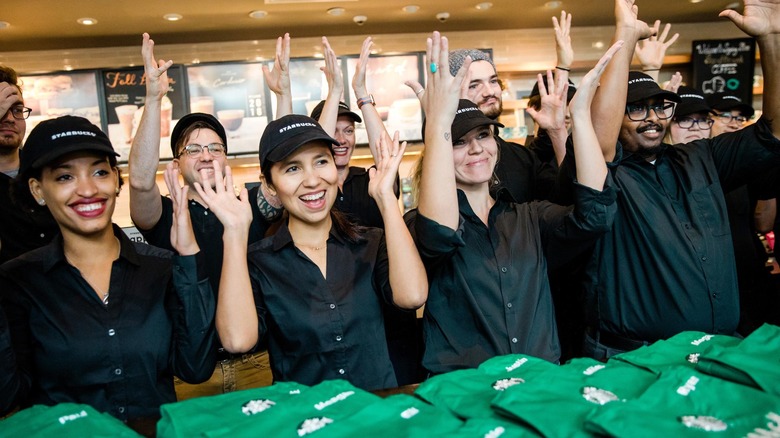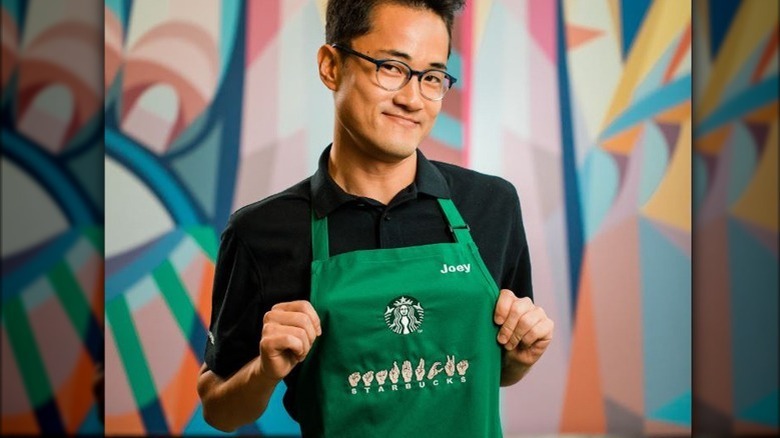What Is A Starbucks Signing Store And Where Did The First One Open?
Starbucks is well known for proactive community involvement and pushing cultural boundaries. In that vein, it's unsurprising the company operates a collection of "signing stores" spanning multiple countries. A dedicated Starbucks Signing Store provides employment opportunities for Deaf and Hard of Hearing individuals, who become full-fledged "partners," a designation referring to all company employees.
While the signing stores facilitate careers for those who might otherwise struggle to thrive in the mainstream workplace, they also have a wider reach. The locations serve as gathering spots for others in the deaf community and often host resourceful seminars and classes on topics such as career development and learning or improving sign-language skills.
The first Starbucks Signing Store opened its doors in 2016, welcoming Deaf retail partners to the new Bangsar Village II mall location in Kuala Lumpur, Malaysia. It was the culmination of an intense training program aided by The Society of Interpreters for the Deaf (SID), which included interpretation for the store's 10 Hard of Hearing partners and sign-language instruction for its three hearing partners.
By the time the second Malaysian signing store opened in Penang three years later, Starbucks spoke of values and perspectives garnered from the resounding success of the Kuala Lumpur experience. In a Starbucks Stories news release, Sydney Quays, managing director of Starbucks Malaysia & Brunei, stressed the "importance of representation and belonging in the workplace," noting how varying viewpoints can enhance the overall business while improving the lives of those around us.
More signing stores and how they work
By December 2022, Starbucks Signing Stores had expanded to 17 locations, including one in Washington, D.C., and others in Japan, China, and Asia. They're all part of the broader Starbucks Community Stores project that seeks to enhance under-resourced communities and support farmers, veterans, youth, and other unique pockets of society.
The opening in Jakarta, Indonesia, showcases Bisindo sign language throughout the store's signage, merchandise, and décor. Most notable is the elaborate 13-foot-high mural spreading across the store and about 36 feet outside. The painting is the work of Deaf Indonesian artist Indira Natalia, who noted how the piece depicts people from varying life experiences communicating via sign language, stating that, "Art can break boundaries and unite people, just like the connection people share when they drink coffee" (via Starbucks Stories Asia).
Both simple and innovative technology make the signing-store experience flow. In Penang, customers and partners communicate via touch points such as visual alarms and digital trays, and the point-of-sale machinery includes displays for customer viewing and verification. Some locations have two-way keyboards for digital conversations, others use digital tablets or notebooks, and most scatter visual displays throughout the store.
America's first Starbucks Signing Store
At the Washington D.C. signing store, America's first Deaf Starbucks, a simple chalkboard highlights a "sign of the week," encouraging even hearing customers from the lively Gallaudet University district to expand their interaction with and knowledge of the Deaf community.
All partners are fluent in American Sign Language (ASL), and hearing partners wear "I Sign" lapel pins, which is a common practice at all deaf-friendly Starbucks Signing Stores. A mural by Deaf artist and adjunct professor Yiqiao Wang merges signs and symbols from ASL with components of coffee and Deaf cultures.
Even more striking in the D.C. store is the incorporation of Gallaudet University's DeafSpace Project, which pinpoints how Deaf people navigate environmental aspects of daily living, such as space, light, color, proximity, mobility, acoustics, and sensory reach. Consequently, the Starbucks Signing Store provides accommodations such as anti-glare surfaces and expanded open spaces for better visual communication.


